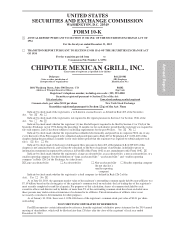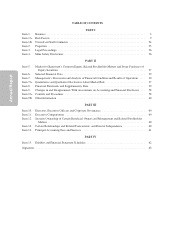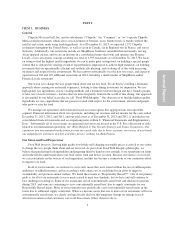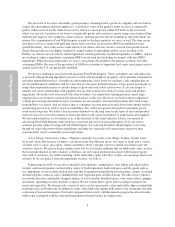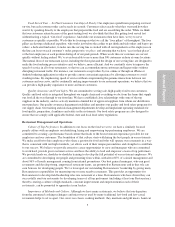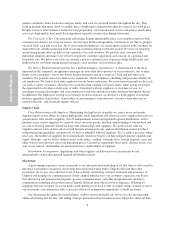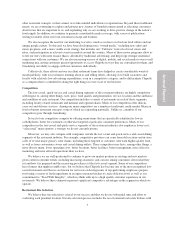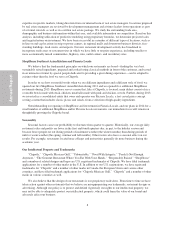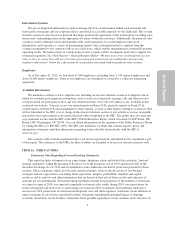Chipotle 2013 Annual Report Download - page 13
Download and view the complete annual report
Please find page 13 of the 2013 Chipotle annual report below. You can navigate through the pages in the report by either clicking on the pages listed below, or by using the keyword search tool below to find specific information within the annual report.
• weather, road construction and other factors limiting access to our restaurants; and
• changes in government regulation.
As a result of these factors it is possible that we will not achieve our targeted comparable restaurant sales or
that the change in comparable restaurant sales could be negative. A number of these factors are beyond our
control, and therefore we cannot assure that we will be able to sustain comparable restaurant sales increases.
Past declines in our comparable restaurant sales increases have significantly impacted our stock price.
Beginning in the second quarter of 2012, prior to which we had been experiencing strong comparable restaurant
sales growth momentum, our comparable restaurant sales increases decelerated and the price of our stock
declined significantly in the wake of this deceleration, including a decline of nearly 22% on the trading day
following our second quarter 2012 earnings release. Any future deceleration in or failure to meet market
expectations for our comparable restaurant sales increases would likely result in another significant decline in the
price of our common stock.
Increasing our sales and profitability depends substantially on our ability to open new restaurants in sites
and on terms attractive to us, which is subject to many unpredictable factors.
There were 1,595 restaurants in operation as of December 31, 2013. We plan to increase the number of our
restaurants significantly in the next three years, and plan to open between 180 and 195 new restaurants in 2014.
However, we have in the past experienced delays in opening some restaurants and that could happen again as a
result of any of the following factors:
• our potential inability to locate and secure new restaurant sites in locations that we believe to be
attractive;
• obstacles to hiring and training qualified operating personnel in the local market;
• delay or cancellation of new site development by developers and landlords, which may become
increasingly common during periods of economic uncertainty or tight credit;
• difficulty managing construction and development costs of new restaurants at affordable levels,
particularly in competitive markets;
• difficulty negotiating leases with acceptable terms;
• any shortages of construction materials and labor;
• lack of availability of, or inability to obtain, adequate supplies of ingredients that meet our quality
standards;
• failures or delays in securing required governmental approvals (including construction, parking and
other permits); and
• the impact of inclement weather, natural disasters and other calamities.
One of our biggest challenges in opening new restaurants is staffing. We seek to hire only top-performing
employees and to promote general managers from our crew, which may make it more difficult for us to staff all
the restaurants we intend to open. Constraints on our hiring new employees are described further below under
“Risks Related to Operating in the Restaurant Industry—Our business could be adversely affected by increased
labor costs or difficulties in finding the right employees for our restaurants and the right field leaders.”
Another significant challenge is locating and securing an adequate supply of suitable new restaurant sites.
Competition for suitable new restaurant sites in our target markets can be intense, and development and leasing
costs are increasing, particularly for urban locations. These factors may be exacerbated by any ongoing economic
uncertainty, as developers may continue to delay or be unable to finance new projects. Delays or failures in
opening new restaurants due to any of the reasons set forth above could materially and adversely affect our
growth strategy and our expected results. Moreover, as we open and operate more restaurants our rate of
expansion relative to the size of our restaurant base will decline, which may in turn slow our sales and
profitability growth.
11
Annual Report


